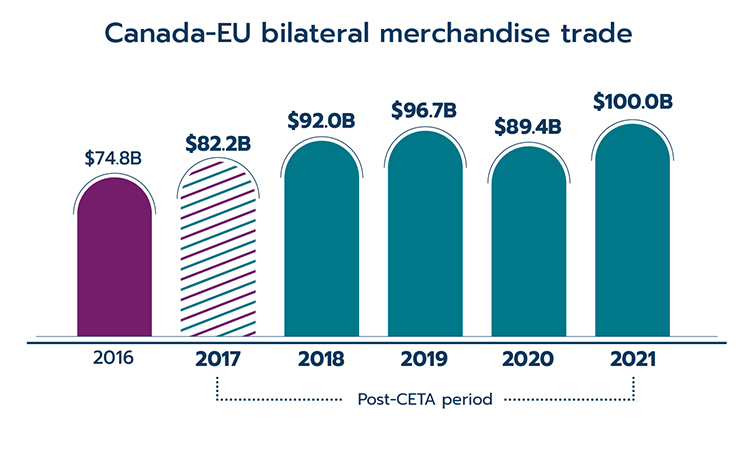CETA@5: Delivering trade benefits during unprecedented times
It’s been just over five years since the Canada–European Union (EU) Comprehensive Economic and Trade Agreement (CETA) provisionally entered into force on September 21, 2017. Despite the pandemic‑related challenges of the past two‑plus years, two‑way merchandise trade between Canada and the EU has grown tremendously in the past five years, reaching a record high of $100 billion in 2021, according to a new report prepared by the Office of the Chief Economist at Global Affairs Canada to mark the fifth anniversary of CETA.
Canadian merchandise trade with the EU increased by 33.7% since CETA's implementation, outpacing the 18.6% growth in Canadian merchandise trade overall. Gains were widespread as trade with nearly every EU member improved over CETA's lifespan to date.

Canada–EU bilateral merchandise trade
| Year | Value ($B) |
|---|---|
| 2016 | 74.8 |
| 2017 | 82.2 |
| 2018 | 92.0 |
| 2019 | 96.7 |
| 2020 | 89.4 |
| 2021 | 100.0 |
Data: Eurostat and Statistics Canada
Canadian merchandise exports to the EU, meanwhile, reached a record high of $32.5 billion in 2021, an increase of 46.4% since 2016. While Germany and Belgium remain Canada's largest export markets in the EU, a number of smaller economies recorded significant growth in exports from Canada, including Latvia, the Czech Republic and Greece.
In addition to the impressive growth in trade values, more Canadian companies are exporting to the EU compared to the pre‑CETA period. A total of 538 net new Canadian companies started exporting to the EU from 2016 to 2019 (a 6.9% increase), the large majority being small and medium‑sized enterprises (SMEs).
One of the major advantages of CETA is the elimination of duties on almost all exports of Canadian goods to the EU. According to the new report, Canadian exports of products that enjoyed tariff reductions through CETA grew by 24.6% between 2016 and 2021, with products that saw the largest tariff reductions seeing the largest growth.
Thanks to CETA, it's estimated that as much as $890.6 million was saved in duties in 2021 alone, which contributes to increased competitiveness for Canadian businesses and reduced prices for Canadian consumers. Nevertheless, there’s still room for improvement. In fact, businesses could gain as much as $415.5 million more in tariff savings by increasing their use of tariff preferences under CETA!
Consult the CETA@5 report for more information.
CETA benefits for businesses
WATCH: CETA makes EU sales possible for this small business
Last November, CanadExport brought you the story of Quebec‑based WaterShed Monitoring and its expansion into European countries with the help of the Trade Commissioner Service (TCS) and CETA.
In this new video from the TCS, WaterShed’s CEO, Sonja Behmel, talks about how her cleantech company has used CETA to win procurement contracts, find new customers and set up an office for its software services.
CETA offers a number of benefits that help Canadian companies, including SMEs, grow their business by making it easier and less expensive to trade with the EU.
CETA:
- Increases competitiveness:: With lower or no tariffs, it costs less to sell Canadian products in EU markets
- Provides access to new customers, including foreign governments: Under the agreement, Canadian companies can bid on opportunities at all levels of the massive EU government procurement market
- Makes trade with the EU more predictable, transparent and accessible: CETA promotes fair business practices and creates a level playing field with enforceable rules
- Removes barriers to trade: CETA reduces border‑crossing delays, which gets your product to EU markets market more quickly
- Improves access for service‑providing companies: With a few exceptions, your services company will be treated the same way as those from the EU
Visit the CETA webpage for more information on these and other cost and time‑saving advantages.
Subscribe to: CanadExport
